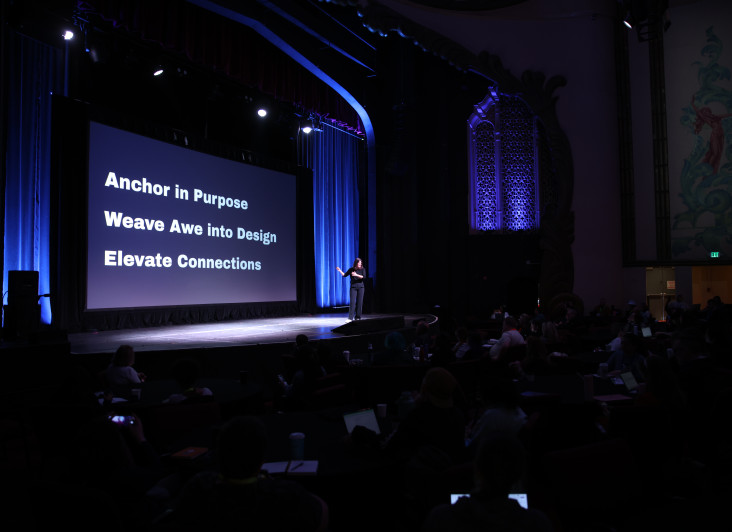The power of place: Creating intentional spaces in your community

According to a HubSpot report, 23% of people say the most significant benefit they get from participating in online communities is a sense of belonging. And community leaders agree. Nearly half of community leaders said the primary purpose of their online community is to provide belonging.
The feeling of ‘belonging’ must be carefully nurtured and requires intentional design. This strategic approach considers every interaction, from the initial community invite to long-term engagement.
Let’s explore how to create intentional online spaces that encourage belonging and engagement. Whether you’re running a large-scale community platform or a cohort, these strategies will help you design a space that invites participation, positive interactions, and encourages member feedback.
Who are you designing for?
Belonging starts with how people first encounter your online community. An invitation is more than a simple request to join—it’s the beginning of your members’ relationship with the community.
Three key things to remember with your member invitation are:
1. Clarity and transparency
When sending out invitations to your ideal community members, be transparent about the community’s mission, values, and what members can expect to gain. Use welcoming language that emphasises an openness to new ideas and perspectives.
2. Personalisation
78% of customers expect more personalisation in interactions than ever before. Customise your invites to resonate with the individuals you’re reaching. A personal touch, whether in tone or format, can make prospective members feel valued—even before they join.
3. Involve current members
If possible, encourage existing members to invite like-minded individuals. A referral from someone already in the community brings trust and signals to new members that this is a place worth investing in.
Entry and early engagement
The experience members have during their initial interactions in the community will set the tone for their future engagement.
These early moments determine whether a new member feels welcomed or completely out of place. That’s why creating an inclusive entry process is vital.
Think about warm welcomes
We’ve previously discussed the value of a community welcome for data collection, but a strong community welcome does much more.
Personalised greetings or welcome threads allow current members to introduce themselves and immediately make newcomers feel seen and appreciated.
Clear participation guidance
Presenting community guidelines at the start helps newcomers find their feet. You might have guidelines on the following:
How to engage
What’s encouraged
Any standards for behaviour
This guidance can also include actionable suggestions. For example, tell them how they can jump in and get involved, such as sharing a favourite resource or responding to an introductory question.

Assign community roles
Consider assigning ‘welcome hosts’ who can reach out to new members of your online community. These members can help to answer questions and offer support as new members learn about the space.
This role can be particularly effective in larger communities to stop a new member from feeling like a small fish in a big pond.
Participation and contribution (The HEART of belonging)
Creating a feeling of belonging allows community members to contribute in meaningful ways.
Jeanine Stewart, a consultant with the Neuroleadership Institute, explained:
“Being surrounded by other human beings doesn’t guarantee a sense of belonging. Belonging actually has to do with identification as a member of a group and the higher quality interactions which come from that. It’s the interactions over time which are supportive of us as full, authentic human beings.”
Contribution, both large and small, helps members feel like they’re part of something bigger and gives them a stake in the community’s growth and success.
How to encourage member contribution
Facilitative diverse interactions. Design spaces for both structured and casual conversations. Offer a range of discussion formats so all members can participate in ways that suit their preferences. This might be Q&As, hybrid events, or even in-person dinners for your most engaged members.
Create opportunities for skill sharing. Encourage members to share knowledge and skills. You might do this through a dedicated thread for tips or a workshop series led by community members. Highlighting member contributions builds their connection to the community (remember the participation ladder!)
Encourage group-driven content. Give members the autonomy to suggest topics or create threads. This will allow them to take ownership of the community’s content. Members are more likely to participate when they have a hand in shaping discussions.
The importance of feedback
So far, we’ve looked at how people feel they belong in spaces they are seen and heard. But belonging goes further than being able to say Hello! or create content. As a community leader, you also have to make a space for member feedback (good and bad!).
When members feel they can safely voice concerns, they’re more likely to trust the community’s leadership and remain engaged.
But how do you create space for member feedback?
Design a feedback process
Having regular check-ins where members can share feedback on their community experiences is a must. You can collect feedback in various forms, including:
Surveys
Suggestion boxes
Discussion threads
Transparent communication about how you will use this feedback will also help create a sense of respect and appreciation amongst your members.

Allow constructive disagreements
Healthy communities allow for differing perspectives. Create guidelines for constructive disagreements, where community members can voice alternative views respectfully.
This could be done in a specific thread or even a community guideline that encourages open dialogue on challenging topics.
Value and respond
Acknowledge any and all member feedback and explain how you will use it or why certain suggestions may not be implemented. Being transparent at all times reinforces a members’ sense of belonging and trust in your community’s intentions.
Design meaningful exit and re-entry points
Remember, belonging isn't always a continuous presence. Sometimes members need a break or may need to leave altogether. Designing respectful exit and re-entry points recognises this need and encourages members to return whenever they’re ready.
Always offer options for pausing engagement
Some members may need time away without completely leaving your online community. Allowing members to pause notifications, mute threads, or temporarily opt out gives them the flexibility to manage their engagement based on their circumstances.
People also like to feel in control of their own decisions. Giving them ways to pause or leave puts the power back in their hands.
A positive and welcoming re-entry
When members come back, make their re-entry as seamless and welcoming as their original entry! Send them a welcome-back message and offer a brief update on what’s been happening in the community so they feel reintegrated instantly.
Design for graceful exits
If a member does decide to leave, make it an easy and respectful process. Allow them to provide feedback and leave the door open if they want to return. Respectful exits reinforce that your online community values members as individuals rather than just active contributors.
Building a community with purpose
Creating an online community where members feel they belong requires intentional design. Community leaders can create spaces that encourage continuous engagement and inclusivity by carefully considering every stage—from initial invitation to possible exits—and designing meaningful ways to engage.
The result is a community where members feel seen and valued. This will build a lasting sense of belonging in your community that’s as resilient as it is welcoming.
If you’re looking for help to make your community more intentional with its design and ensure your members feel like they belong, get in touch with our team today!
At Steadfast Collective, we’re community builders. We’re dedicated to creating spaces where your members can easily engage and feel part of something bigger.
More Articles

When to Build Your Own Membership Platform (and When Not To)
I’ll let you in on a secret, not every membership organisation needs a bespoke membership platform.

Design for AWE
Anchor. Wonder. Connection. The blueprint for unforgettable memberships.

Community building - the LEGO way
I recently had the chance to speak with Jake McKee, who is a principal consultant, who has worked with or for the likes of LEGO, Apple and many more.

